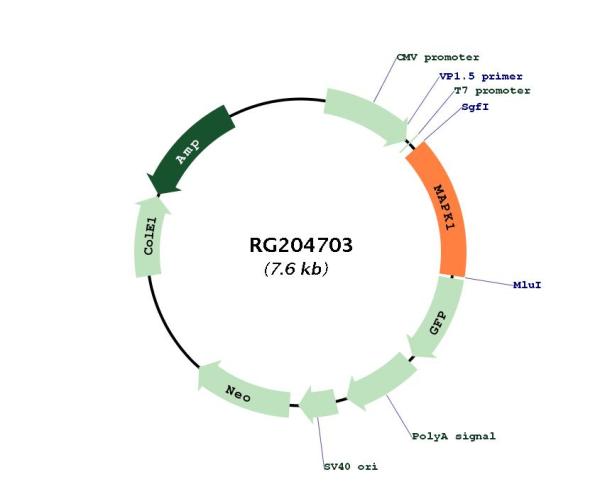ERK2 (MAPK1) (NM_138957) Human Tagged ORF Clone
CAT#: RG204703
- TrueORF®
MAPK1 (tGFP-tagged) - Human mitogen-activated protein kinase 1 (MAPK1), transcript variant 2
ORF Plasmid: DDK
Lentiviral Particles: DDK DDK w/ Puro mGFP mGFP w/ Puro
AAV Particle: DDK
"NM_138957" in other vectors (7)
Specifications
| Product Data | |
| Type | Human Tagged ORF Clone |
| Tag | TurboGFP |
| Symbol | ERK2 |
| Synonyms | ERK; ERK-2; ERK2; ERT1; MAPK2; NS13; p38; p40; p41; p41mapk; p42-MAPK; P42MAPK; PRKM1; PRKM2 |
| Vector | pCMV6-AC-GFP |
| E. coli Selection | Ampicillin (100 ug/mL) |
| Mammalian Cell Selection | Neomycin |
| Sequence Data |
>RG204703 representing NM_138957
Red=Cloning site Blue=ORF Green=Tags(s) TTTTGTAATACGACTCACTATAGGGCGGCCGGGAATTCGTCGACTGGATCCGGTACCGAGGAGATCTGCC GCCGCGATCGCC ATGGCGGCGGCGGCGGCGGCGGGCGCGGGCCCGGAGATGGTCCGCGGGCAGGTGTTCGACGTGGGGCCGC GCTACACCAACCTCTCGTACATCGGCGAGGGCGCCTACGGCATGGTGTGCTCTGCTTATGATAATGTCAA CAAAGTTCGAGTAGCTATCAAGAAAATCAGCCCCTTTGAGCACCAGACCTACTGCCAGAGAACCCTGAGG GAGATAAAAATCTTACTGCGCTTCAGACATGAGAACATCATTGGAATCAATGACATTATTCGAGCACCAA CCATCGAGCAAATGAAAGATGTATATATAGTACAGGACCTCATGGAAACAGATCTTTACAAGCTCTTGAA GACACAACACCTCAGCAATGACCATATCTGCTATTTTCTCTACCAGATCCTCAGAGGGTTAAAATATATC CATTCAGCTAACGTTCTGCACCGTGACCTCAAGCCTTCCAACCTGCTGCTCAACACCACCTGTGATCTCA AGATCTGTGACTTTGGCCTGGCCCGTGTTGCAGATCCAGACCATGATCACACAGGGTTCCTGACAGAATA TGTGGCCACACGTTGGTACAGGGCTCCAGAAATTATGTTGAATTCCAAGGGCTACACCAAGTCCATTGAT ATTTGGTCTGTAGGCTGCATTCTGGCAGAAATGCTTTCTAACAGGCCCATCTTTCCAGGGAAGCATTATC TTGACCAGCTGAACCACATTTTGGGTATTCTTGGATCCCCATCACAAGAAGACCTGAATTGTATAATAAA TTTAAAAGCTAGGAACTATTTGCTTTCTCTTCCACACAAAAATAAGGTGCCATGGAACAGGCTGTTCCCA AATGCTGACTCCAAAGCTCTGGACTTATTGGACAAAATGTTGACATTCAACCCACACAAGAGGATTGAAG TAGAACAGGCTCTGGCCCACCCATATCTGGAGCAGTATTACGACCCGAGTGACGAGCCCATCGCCGAAGC ACCATTCAAGTTCGACATGGAATTGGATGACTTGCCTAAGGAAAAGCTCAAAGAACTAATTTTTGAAGAG ACTGCTAGATTCCAGCCAGGATACAGATCT ACGCGTACGCGGCCGCTCGAG - GFP Tag - GTTTAA >RG204703 representing NM_138957
Red=Cloning site Green=Tags(s) MAAAAAAGAGPEMVRGQVFDVGPRYTNLSYIGEGAYGMVCSAYDNVNKVRVAIKKISPFEHQTYCQRTLR EIKILLRFRHENIIGINDIIRAPTIEQMKDVYIVQDLMETDLYKLLKTQHLSNDHICYFLYQILRGLKYI HSANVLHRDLKPSNLLLNTTCDLKICDFGLARVADPDHDHTGFLTEYVATRWYRAPEIMLNSKGYTKSID IWSVGCILAEMLSNRPIFPGKHYLDQLNHILGILGSPSQEDLNCIINLKARNYLLSLPHKNKVPWNRLFP NADSKALDLLDKMLTFNPHKRIEVEQALAHPYLEQYYDPSDEPIAEAPFKFDMELDDLPKEKLKELIFEE TARFQPGYRS TRTRPLE - GFP Tag - V |
| Restriction Sites |
SgfI-MluI
Cloning Scheme for this gene
Plasmid Map

|
| ACCN | NM_138957 |
| ORF Size | 1080 bp |
| OTI Disclaimer | The molecular sequence of this clone aligns with the gene accession number as a point of reference only. However, individual transcript sequences of the same gene can differ through naturally occurring variations (e.g. polymorphisms), each with its own valid existence. This clone is substantially in agreement with the reference, but a complete review of all prevailing variants is recommended prior to use. More info |
| OTI Annotation | This clone was engineered to express the complete ORF with an expression tag. Expression varies depending on the nature of the gene. |
| Product Components | The ORF clone is ion-exchange column purified and shipped in a 2D barcoded Matrix tube containing 10ug of transfection-ready, dried plasmid DNA (reconstitute with 100 ul of water). |
| Reconstitution | 1. Centrifuge at 5,000xg for 5min. 2. Carefully open the tube and add 100ul of sterile water to dissolve the DNA. 3. Close the tube and incubate for 10 minutes at room temperature. 4. Briefly vortex the tube and then do a quick spin (less than 5000xg) to concentrate the liquid at the bottom. 5. Store the suspended plasmid at -20°C. The DNA is stable for at least one year from date of shipping when stored at -20°C. |
| Reference Data | |
| RefSeq | NM_138957.3 |
| RefSeq Size | 1499 bp |
| RefSeq ORF | 1083 bp |
| Locus ID | 5594 |
| UniProt ID | P28482 |
| Cytogenetics | 22q11.22 |
| Domains | pkinase, TyrKc, S_TKc |
| Protein Families | Druggable Genome, Protein Kinase |
| Protein Pathways | Acute myeloid leukemia, Adherens junction, Alzheimer's disease, Axon guidance, B cell receptor signaling pathway, Bladder cancer, Chemokine signaling pathway, Chronic myeloid leukemia, Colorectal cancer, Dorso-ventral axis formation, Endometrial cancer, ErbB signaling pathway, Fc epsilon RI signaling pathway, Fc gamma R-mediated phagocytosis, Focal adhesion, Gap junction, Glioma, GnRH signaling pathway, Insulin signaling pathway, Long-term depression, Long-term potentiation, MAPK signaling pathway, Melanogenesis, Melanoma, mTOR signaling pathway, Natural killer cell mediated cytotoxicity, Neurotrophin signaling pathway, NOD-like receptor signaling pathway, Non-small cell lung cancer, Oocyte meiosis, Pancreatic cancer, Pathways in cancer, Prion diseases, Progesterone-mediated oocyte maturation, Prostate cancer, Regulation of actin cytoskeleton, Renal cell carcinoma, T cell receptor signaling pathway, TGF-beta signaling pathway, Thyroid cancer, Toll-like receptor signaling pathway, Type II diabetes mellitus, Vascular smooth muscle contraction, VEGF signaling pathway |
| Gene Summary | This gene encodes a member of the MAP kinase family. MAP kinases, also known as extracellular signal-regulated kinases (ERKs), act as an integration point for multiple biochemical signals, and are involved in a wide variety of cellular processes such as proliferation, differentiation, transcription regulation and development. The activation of this kinase requires its phosphorylation by upstream kinases. Upon activation, this kinase translocates to the nucleus of the stimulated cells, where it phosphorylates nuclear targets. One study also suggests that this protein acts as a transcriptional repressor independent of its kinase activity. The encoded protein has been identified as a moonlighting protein based on its ability to perform mechanistically distinct functions. Two alternatively spliced transcript variants encoding the same protein, but differing in the UTRs, have been reported for this gene. [provided by RefSeq, Jan 2014] |
Documents
| Product Manuals |
| FAQs |
| SDS |
Resources
Other Versions
| SKU | Description | Size | Price |
|---|---|---|---|
| RC204703 | MAPK1 (Myc-DDK-tagged)-Human mitogen-activated protein kinase 1 (MAPK1), transcript variant 2 |
USD 457.00 |
|
| RC204703L1 | Lenti ORF clone of Human mitogen-activated protein kinase 1 (MAPK1), transcript variant 2, Myc-DDK-tagged |
USD 757.00 |
|
| RC204703L2 | Lenti ORF clone of Human mitogen-activated protein kinase 1 (MAPK1), transcript variant 2, mGFP tagged |
USD 757.00 |
|
| RC204703L3 | Lenti ORF clone of Human mitogen-activated protein kinase 1 (MAPK1), transcript variant 2, Myc-DDK-tagged |
USD 757.00 |
|
| RC204703L4 | Lenti ORF clone of Human mitogen-activated protein kinase 1 (MAPK1), transcript variant 2, mGFP tagged |
USD 757.00 |
|
| SC109616 | MAPK1 (untagged)-Human mitogen-activated protein kinase 1 (MAPK1), transcript variant 2 |
USD 686.00 |
|
| SC323422 | MAPK1 (untagged)-Kinase deficient mutant (K54M) of Human mitogen-activated protein kinase 1 (MAPK1), transcript variant 2 |
USD 686.00 |
{0} Product Review(s)
Be the first one to submit a review






























































































































































































































































 Germany
Germany
 Japan
Japan
 United Kingdom
United Kingdom
 China
China

